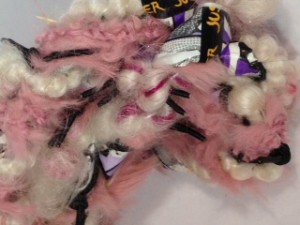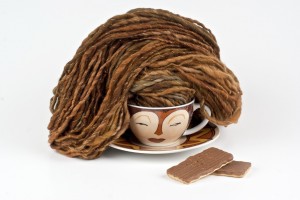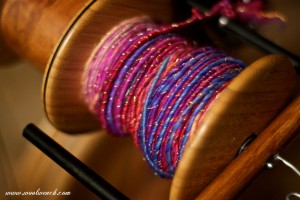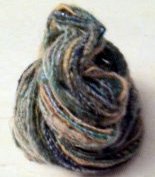It’s debate time again!!!! You know we love a controversial topic here at Fibery Goodness and this topic is a good one that I’m sure will spark some interest…Enjoy!
 Arlene: So…when I started spinning, all I wanted to spin was “art yarn”. I could not have cared less about the technical aspects of what I was doing. In fact, as soon as I heard classic terms like “woolen” and “worsted”, my eyes would glaze over and my mind would drift into daydream land. I just wanted to get in there and get my hands on the fiber, throw gobs of it through the orifice and have some chunky, weird hot mess come off the bobbin.
Arlene: So…when I started spinning, all I wanted to spin was “art yarn”. I could not have cared less about the technical aspects of what I was doing. In fact, as soon as I heard classic terms like “woolen” and “worsted”, my eyes would glaze over and my mind would drift into daydream land. I just wanted to get in there and get my hands on the fiber, throw gobs of it through the orifice and have some chunky, weird hot mess come off the bobbin.
Fast forward to today, I get that it’s important, but using that information still doesn’t really turn me on.
 Suzy: Well maybe you have been using that information all along, but you just didnt know it! When you wanted to make a light fluffy yarn, or decided you might need a smooth single to ply with something else.. what did you do about preparing your fibers for those yarns? You were probably making woolen and worsted preparations to create the kind of yarns you had in mind. I know at some point you said you realised that fiber prep is everything, and to make a fluffy yarn you need a fluffy prep. Most likely you then spun that with as little smoothing down of the fibers as possible… and voila! A woolen yarn is born!
Suzy: Well maybe you have been using that information all along, but you just didnt know it! When you wanted to make a light fluffy yarn, or decided you might need a smooth single to ply with something else.. what did you do about preparing your fibers for those yarns? You were probably making woolen and worsted preparations to create the kind of yarns you had in mind. I know at some point you said you realised that fiber prep is everything, and to make a fluffy yarn you need a fluffy prep. Most likely you then spun that with as little smoothing down of the fibers as possible… and voila! A woolen yarn is born!
 Arlene: Hey, for a long time, I was lucky just to be able to make something that held together!!! Being the least mechanical person possible, getting my hands and feet to do something unique AND cooperatively at the same time seemed like enough. Learning terminology was the last thing on my mind. And, to add to all of this, my knitter’s mind wanted “worsted” to be all about “worsted weight yarn”. My beginning spinning classes contained the information but it was just too much for me to take in.
Arlene: Hey, for a long time, I was lucky just to be able to make something that held together!!! Being the least mechanical person possible, getting my hands and feet to do something unique AND cooperatively at the same time seemed like enough. Learning terminology was the last thing on my mind. And, to add to all of this, my knitter’s mind wanted “worsted” to be all about “worsted weight yarn”. My beginning spinning classes contained the information but it was just too much for me to take in.
But, yes, you are right. I have said that fiber prep is everything (although fiber selection comes first). However, I’m living proof that you can ignore learning the terms and sort of figure your way along in terms of how to prepare your fiber to get the outcome you are seeking, so maybe the question really is how far can you go down the path of learning to spin without really understanding these terms and what they mean? Where are you going to get stuck without comprehending the information?
 Suzy: its true, its all arbitrary, naming things. I am pretty sure you could go anywhere with spinning without ever learning the ‘known’ names for what you are doing, maybe you would end up inventing your own, like ‘I want to make a fluffy cosy gersey so I need to prep a fluff batt on the carder’ – knowing that the only way to get your yarn fluffy is to card it and make it… fluffy. Then you might think ‘oh now I need to spin it the hotchpotch way’ which in your own mind is something resembling long draw, only you dont know what longdraw is, just what hotchpotch spinning is, because you made it up. The only hiccup with all this is if you wanted to share what you know, or if you wanted to talk to other spinners about what you do. Or if you picked up a book and saw ‘woolen’ spinning in it, you’re thinking ‘of course its woolen, I am spinning wool, right?’. Eventually it gets confusing. I think in almost any area of specialisation there comes a new variety of language, like legal language is known as ‘legalese’. I guess what we have is ‘spinese’. A vocabulary specific to spinning. I think a lot of these ‘eses’ are simply confusing when you first discover them, I mean, it IS learning a new language.. but in the long term I think its handy to be able to use it to communicate and understand. I remember learning stuff in Anthropology class about culture and how its made of ‘shared meanings’. I think we have a spinning culture that has them too, and understanding that when someone says ‘worsted yarn’ in relation to spinning, means a smooth yarn made with combed fiber, is one of those shared meanings.
Suzy: its true, its all arbitrary, naming things. I am pretty sure you could go anywhere with spinning without ever learning the ‘known’ names for what you are doing, maybe you would end up inventing your own, like ‘I want to make a fluffy cosy gersey so I need to prep a fluff batt on the carder’ – knowing that the only way to get your yarn fluffy is to card it and make it… fluffy. Then you might think ‘oh now I need to spin it the hotchpotch way’ which in your own mind is something resembling long draw, only you dont know what longdraw is, just what hotchpotch spinning is, because you made it up. The only hiccup with all this is if you wanted to share what you know, or if you wanted to talk to other spinners about what you do. Or if you picked up a book and saw ‘woolen’ spinning in it, you’re thinking ‘of course its woolen, I am spinning wool, right?’. Eventually it gets confusing. I think in almost any area of specialisation there comes a new variety of language, like legal language is known as ‘legalese’. I guess what we have is ‘spinese’. A vocabulary specific to spinning. I think a lot of these ‘eses’ are simply confusing when you first discover them, I mean, it IS learning a new language.. but in the long term I think its handy to be able to use it to communicate and understand. I remember learning stuff in Anthropology class about culture and how its made of ‘shared meanings’. I think we have a spinning culture that has them too, and understanding that when someone says ‘worsted yarn’ in relation to spinning, means a smooth yarn made with combed fiber, is one of those shared meanings.
The downside is it can seem a bit elitist, snobby even, when you first find this stuff out, like a language only for ‘those on the inside’. Do you think there is a way we can use these terms and avoid the initial confusion and elitism that can be associated with it?
 Arlene: You read my mind. It can be very elitist…”Oh, she’s been spinning for two years and she still doesn’t know the difference between this and that…she doesn’t know how to long draw…oh, she doesn’t even know what long draw is…poor thing, bless her heart.” I think spinners that come into the discipline wanting to spin non-traditional yarns face this a lot. There’s a prejudice about not being a real spinner unless you have mastered the traditions — including the terminology and being able to demonstrate that you can prepare fiber and spin it according to these modalities. And, I guess, you know, deep down, at the outset that kind of rankled my hippy-dippy, anti-authoritarian soul. I don’t like class systems, prejudice, narrowness in any form so…
Arlene: You read my mind. It can be very elitist…”Oh, she’s been spinning for two years and she still doesn’t know the difference between this and that…she doesn’t know how to long draw…oh, she doesn’t even know what long draw is…poor thing, bless her heart.” I think spinners that come into the discipline wanting to spin non-traditional yarns face this a lot. There’s a prejudice about not being a real spinner unless you have mastered the traditions — including the terminology and being able to demonstrate that you can prepare fiber and spin it according to these modalities. And, I guess, you know, deep down, at the outset that kind of rankled my hippy-dippy, anti-authoritarian soul. I don’t like class systems, prejudice, narrowness in any form so…
In answer to your question, can we separate out the negative aspects of using these terms?
Um, we have to.
 When I was learning to sail a boat, I was told by my salty-dog of a sailing teacher, “Look, sailing involves a lot of terminology that is going to be unfamiliar to you at first. But, it is required that you study it and know it because I’m going to bark out orders to you on the boat using those terms and if you don’t understand what I’m saying, we could all be killed.” And, sure enough, during one lesson, one of the guys hadn’t bothered to learn the terms after about six weeks of sailing and we ran into some weather and the salty dog teacher was yelling at him to do something very important and he couldn’t follow the commands. Let’s say he learned his lesson. Now, I’m not comparing spinning to a life and death situation on the water, but I’m illustrating that I agree with you — like it or lump it! These terms have been around for a long time and they are here to stay. Having a common language is just necessary.
When I was learning to sail a boat, I was told by my salty-dog of a sailing teacher, “Look, sailing involves a lot of terminology that is going to be unfamiliar to you at first. But, it is required that you study it and know it because I’m going to bark out orders to you on the boat using those terms and if you don’t understand what I’m saying, we could all be killed.” And, sure enough, during one lesson, one of the guys hadn’t bothered to learn the terms after about six weeks of sailing and we ran into some weather and the salty dog teacher was yelling at him to do something very important and he couldn’t follow the commands. Let’s say he learned his lesson. Now, I’m not comparing spinning to a life and death situation on the water, but I’m illustrating that I agree with you — like it or lump it! These terms have been around for a long time and they are here to stay. Having a common language is just necessary.
We can spin however, we like and should not feel embarrassed about how we practice fiber or what we know or don’t know. But, it’s going to be hard to relate to others without learning what these terms mean. In some sense, it’s like going on a trip without your luggage — at some point, you will have to go back after your suitcase.
Well, there you have it. What do you think? How important is it to be “traditionally technical”? Are you a spinner who doesn’t care about these terms and blissfully spins what you like without worrying about this?
I was first taught spinning by Lexi. So naturally -art yarn spinning is just in my “blood”. I think we should just all spin how we feel at the moment and forget all the terminology – just have fun and let the fiber speak to you.
I throw the terms to the wind, but if I spin with intent, and purpose, and am using washed locks, I spin woolen. If I am spinning off of top, I have to admit I normally spin worsted. Sometimes I like the way one looks, over the other. Terms are just that, they don’t make a spinner good or bad. LOL
I love the topic. I just came off teaching middle schoolers how to drop spindle for their home crafters study and smile as I remember what they did NOT know…like if you do not pull out the fibers, and yet try to make it twist, a lot of nothing is accomplished and it is frustrating. Just the idea of making the fibers ready to be twisted so you are in charge is very empowering. I quickly follow this with my ‘Great Rule’ : If it holds together, it is good. Thick, thin, lumpy, smooth (surprise!): all is good. By the time the week of work was over, I had 10 students and 3 spinning adults all drop spindling away. They could care less woolen or worsted; they just wanted to fill the spindle. Technical comes after the fun is caught. And even then it is a case of what do you need to know to make the yarn you like.
Personally, I spin smooth (so worsted by default) because my fibers require it: cotton, flax. I spin lofty (woolen) for size of yarn. I spin mixed woolen and worsted for most of my yarns. And I spin crazy…well because I know the rules and want to break them.
Great discussion! Iso connect to what you were saying Arlene. I can say that the journey has helped me to have more intentionality in what I am spinning, and that I appreciate. All forms of art, mechanics, teaching even have their own nomenclature. I found that when I taught some folks used vocabulary as a wedge. It was important for us to use language that was inclusive, and where everyone understood. I do believe there is a common spinning language but it is more about texture and feel, than woolen or worsted!
I learnt to spin so I could make art yarns but felt I needed to know the basics of traditional spinning before I started on art yarns. I also like to know what I’m talking about so learnt as much as I could. Now I do what I like.
I first learnt to spin about 40 yrs ago and was taught by the best spinner in Australia back then, Eve Rashleigh who taught us in a very scientific way – microns, S and Z, woolen and worsted, aiming for an even balanced yarn etc. Like learning how to read music and practise scales as i think back. I’ve now returned to spinning after a break of about 25 or 30 years and all i want to spin is art yarn. I am very, very grateful for my early training as i understand what i’m trying to achieve, even if i don’t always accomplish it.
I don’t really care what other people spin or how they spin it but what really grates with me are people who deliberately try to make it elitist to *not know* the correct terms. I have a friend who is President of the Guild here and has been spinning continuously for much longer than me but who does not know the terms S and Z, and deliberately blocked me when i tried to use these terms in conversation recently. One should at least know the language if one is in position of helping new spinners to understand what it’s all about. My 2 cents worth.
Thats interesting Katie! Another and opposite form of elitism! I guess there are extremes in everything..
Unfortunately it seems to be happening a lot in Australia right now.
I love what you have said. I was also taught by Eve, at Brookvale tafe for 3 years. The way Eve taught and the knowledge she imparted is spinning gold. These days it seems to be not wanted in this age of do it however you want. It makes me feel sad . We know the wonderful spirit of Eve, how blessed are we.
This has article has been so well put. It’s definitely me to a ‘T’. However, others sometimes want to know how I do things, and that’s where the technical terms need to be used . I’m now being forced to polish up on some of that, explaining as I go, that I have bumbled my way for years, so it would be an advantage for them to get familiar with these terms. I do refer them to the internet so they can learn for themselves, or Books on the subject. They will make the effort if they want to. Thanks for voicing what I’ve been internalising for years – I don’t feel quite so slack now 🙂
I started to spin because I wanted to make art yarns, never did I know I would also fall in love with spinning traditional yarns too. I am self-taught, and I spun in “youtubeish” for the first few years, then I got the english terms in.
My hardest part is finding the norwegian words in spinning and using them, and that is both words for techniques and equipment. A good example is “wool picker”, there is no good word for this in Norwegian. Thankfully several of my spinning friends also are self-taught and understand what I mean and talk about 🙂
Once I had a norwegian lady in my spinning group who had spun for several decades and held lots of classes tell me that art yarns IS a waste of time and money. After knowing her for a few years I still have a hard time to relate to her because of the way she looks down on what I do, and she still gives me the evil eye when I spin art yarns… and therefor I often spin artyars in her presence 🙂
In my opinion , you can call it what ever you want, and spin however you want. The most important thing is that you enjoy the process and have lots of fun doing it! What works for you and floats your boat is what is right for YOU.
30 years ago I learned how hand,feet,fiber and wheel worked together. I did not know any names, only spin one direction and ply another. I was hooked on, and I started to spin with big freedom. I bland colors and fiber ,what ever I got in my hands. If I saw a yarn in the store I liked, I tried to get closed to it with using Gold and Silver thread or other thin colored yarn even sewing and
embroidery thread, , to ply with for making a sort of a bumpy feeling yarn with candy colors.
Oh yes, it was exciting,I felt my self very creative and free and I also knitting it in free hand too.
I did not know any one else who spin and I could not find any books in Norway that hit me on this front, but I really missed to learn more about spinning. A few years ago I came in contact with Spinnvilt in Lillehammer Norway, than I also came to the Lexi Boeger pluckyfluff class and i realized that there was so much information, technique and names I never heard before. I had to do something with my knowledge about spinning, so I could be sure of what I did know and to understand how to teach more.
I have been in spinning meeting in Lillehammer last year ( weekend meeting ) with 50 spinners from all the country, amazing 🙂 I am in a Norwegian forum online. And now I am in this class too 🙂 It have been a huge happening in my life ,and I learn something new every day and I also learn about my self and to choose what is important for me.
I need the knowledge for understanding how all this magic doors can be opening to all these unique creative yarns , and to make me safer in communication whit other spinners too. I know I have a long way to go but i loved this road. <3
We have just had our first spinning skill swap and the organiser had prepared a list of topics for discussion and sharing of skills. Funny enough everyone said skip topics like woollen / worsted because most people spin in a way they feel the fibre wants to go. The consensus was that if you want to know these things in depth there are good books out there.
I’m a bit of a geek and I love learning the history and terms associated with this craft. I try to practise different techniques so that I can break out of my comfort zone and create with intent. However you can do that without having to know the jargon.
Thats interesting Jo! Because the way I see it, even when not knowing the terms and just ‘spinning’ as the fiber dictates, you are still spinning one or the other or possibly a semi woolen or worsted, even if you don’t know it! Perhaps its a case of people feeling restricted by the terminology. Also, how are people choosing their fiber preparation methods?
I totally agree, I suppose it only matters what you call it when you have to describe or record what you have done. The group ranged from very experienced traditional spinners to total beginners but everyone prefered to focus on things like N plying and fractal spinning and also trying out equipment such as the hackle and blending board. It was a great day 🙂
In terms of fibre prep I suppose we are all limited by access to equipment. I started out in spinning as a Roman re-enactor so my prep was always worsted as I was limited to using certain breeds, bone combs and a spindle . Now I have a wheel I find it hard to break out of using a short forward draw and my yarns are semi worsted even though my prep is woolen (I haven’t got combs). I have to really concentrate to spin fluffy woolen yarns because of habit.